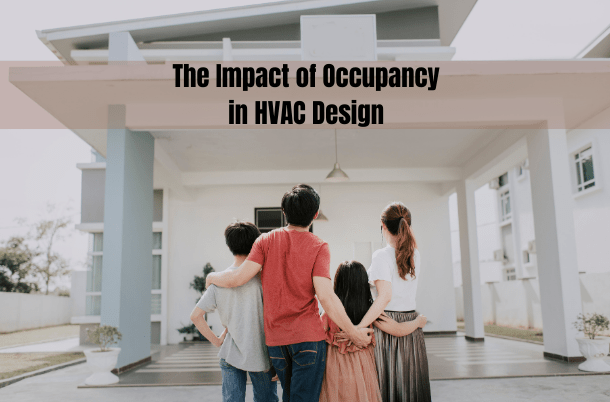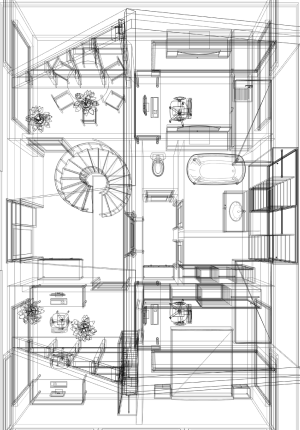The Impact of Occupancy in HVAC Design

When it comes to designing an effective HVAC system, the professionals delve into meticulous calculations to ensure optimal performance and energy efficiency. One of the most critical factors in this process is the number of occupants within a space.
Think of each occupant of a building or home as a unique piece to an intricate puzzle. The HVAC system acts as the skilled puzzle solver, arranging and adapting to the evolving pattern of occupants to maintain a cohesive thermal picture. Like a puzzle coming together seamlessly, a well-designed HVAC system ensures that the indoor climate fits together perfectly, creating a comfortable and balanced environment.
Now, the primary goal of HVAC load calculations is to determine the amount of heating or cooling required to maintain a comfortable indoor environment. Factors such as external weather conditions, insulation, windows, appliances, lighting, and the human factor all play a role in defining the load on the HVAC system.
Humans, with their bodies constantly generating heat, contribute a substantial amount to the overall heat load in a space. Occupants not only produce heat at rest but also generate additional warmth during activities. Whether it’s a bustling office or a serene living room, the number of people present is a key variable that HVAC designers must consider. For residential, occupants are 230 Btuh per person sensible and 200 Btuh per person latent.
Beyond the heat load, the number of occupants also affects ventilation requirements. Proper ventilation is crucial for maintaining indoor air quality by ensuring a steady exchange of fresh outdoor air. The concentration of people in a space influences the amount of CO2 and other contaminants produced, necessitating appropriate ventilation rates for a healthy environment.
One of the challenges in HVAC load calculations is the dynamic nature of occupancy. Spaces that host events or gatherings may experience sudden spikes in the number of occupants. For instance, living rooms are usually estimated to hold all of the household members since it is a space for family gatherings, while bedrooms are estimated to hold at least one person only. One strategy that some codes allow is having an additional HVAC system in event spaces specifically for gatherings. This way they will have enough conditioning for when there are extra people, without being oversized the rest of the time.
Achieving the right balance in HVAC load calculations involves a nuanced approach. Designers must factor in not only the number of occupants but also their activities, the type of space, and the duration of occupancy. This comprehensive analysis ensures that the HVAC system is tailored to the specific needs of the environment it serves.
Property owners or household owners can also improve the efficiency and comfort of your HVAC system in conjunction with maximizing occupants through some of these simple tips:
- Use Zoning Strategies: If possible, implement zoning in your This involves dividing areas into zones with independent temperature control. This way, you can heat or cool specific zones based on occupancy, optimizing comfort and energy use.
- Install Smart Technology: Upgrade to a smart thermostat that can adapt to occupancy These devices can learn habits and adjust temperatures accordingly, optimizing energy usage when spaces are unoccupied. Other than smart thermostats, occupancy sensors are also a good investment. These sensors in rooms automatically adjust lighting and HVAC settings based on the presence or absence of people.
- Efficient Lighting: Opt for energy-efficient lighting solutions to minimize additional heat LED bulbs, for example, produce less heat compared to traditional incandescent bulbs.
- Home Re-decoration: Some simple home decors or appliances can actually have a great impact in achieving an energy-efficient HVAC system, such as ceiling fans and curtains. Ceiling fans can help distribute air more evenly, allowing you to maintain comfort with slightly higher thermostat settings in summer and lower settings in winter. Use curtains or blinds to block out sunlight during hot days and insulate windows during colder periods to minimize the impact of external temperatures on your HVAC system.
- Utilize Natural Ventilation: Take advantage of natural ventilation by opening windows and doors strategically when weather conditions allow. This can provide fresh air and reduce reliance on mechanical ventilation.
- Regular Maintenance: It has always been mentioned, but maintenance of your system can truly go a long way. Keep your HVAC system in top condition by regularly cleaning or replacing air filters. This ensures efficient airflow, reducing the strain on the system.
Of course, implementing these only enhances the efficiency of the HVAC system. For designers, considering the impact of occupants on HVAC load calculations is fundamental to designing systems that are both efficient and responsive.
For all your HVAC Design needs, email us at [email protected]. Our team of experienced professionals is ready to assist you in optimizing your HVAC system for maximum efficiency and comfort. Whether you’re planning a new construction project or considering upgrades to your existing system, we’ve got you
covered.


